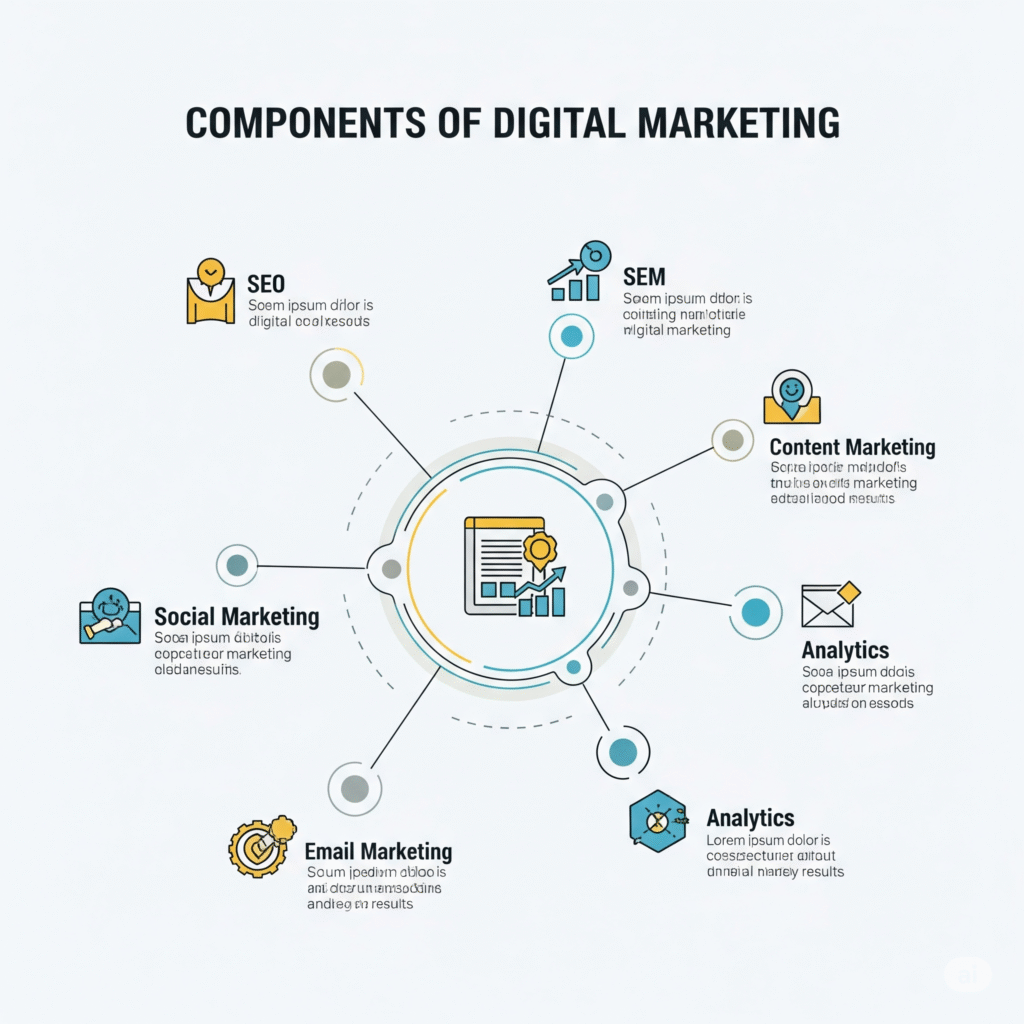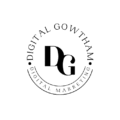
Introduction:
In today’s hyper-connected world, digital marketing has become the backbone of business growth and customer engagement. From startups to multinational corporations, brands across the globe are leveraging digital channels to reach their target audience, generate leads, and drive conversions.
But digital marketing isn’t just one thing; it’s a comprehensive ecosystem made up of several interconnected components. Understanding each part and how they work together is key to building a powerful, results-driven marketing strategy.
Here’s a detailed guide to the core components of digital marketing in 2025 and how they can benefit your brand.
1. Search Engine Optimization (SEO)
SEO is the process of optimizing your website and content to rank higher in search engine results pages (SERPs), primarily on Google.
Key Elements:
On-page SEO: Content optimization, keyword targeting, meta tags, image alt text.
Off-page SEO: Backlinks, guest posts, online PR.
Technical SEO: Site speed, mobile responsiveness, secure connections (HTTPS), structured data.
Why it matters:
Organic search is one of the highest-converting traffic sources. A well-optimized website boosts visibility, trust, and credibility.
Pro tip: Focus on long-tail keywords and voice search optimization as user behavior shifts.
2. Pay-Per-Click Advertising (PPC)
PPC is a form of paid advertising where advertisers pay a fee each time their ad is clicked. Google Ads and Meta Ads (Facebook + Instagram) dominate this space.
Channels:
Google Search Ads
Google Display Network
Facebook & Instagram Ads
LinkedIn Sponsored Content
YouTube Video Ads
Why it matters:
PPC offers immediate visibility and is ideal for targeted campaigns like product launches, event promotions, or lead generation.
Pro Tip: Monitor ad performance regularly and use A/B testing to improve click-through and conversion rates.
3. Content Marketing
Content is still king, but now it’s also about context and value. Content marketing involves creating and distributing relevant, useful content to attract and retain a defined audience.
Formats:
Blog posts
E-books/whitepapers
Videos and reels
Infographics
Case studies
Webinars and podcasts
Why it matters:
Content not only supports SEO but also educates, entertains, and nurtures potential customers along the buying journey.
Pro Tip: Use a content calendar and repurpose content across formats and platforms to maximize ROI.
4. Social Media Marketing (SMM)
With billions of users active on platforms like Instagram, LinkedIn, Facebook, TikTok, and X (Twitter), social media is where people discover, follow, and interact with brands.
Strategies include:
Organic content (reels, stories, posts)
Paid ads and promotions
Influencer collaborations
Social listening and customer support
Why it matters:
Social media is excellent for brand awareness, customer engagement, and even direct sales through social commerce.
Pro Tip: Choose platforms that align with your audience. B2B? Focus on LinkedIn. B2C or Gen Z? Try Instagram and TikTok.
5. Email Marketing
Despite being one of the oldest digital channels, email marketing continues to deliver high ROI. It’s a powerful tool for nurturing leads, customer retention, and personalized communication.
Common campaigns:
Newsletters
Product updates
Special promotions
Cart abandonment reminders
Drip campaigns
Why it matters:
Email allows direct communication with people who have opted in to hear from you, making it a warm audience.
Pro Tip: Segment your audience and personalize subject lines and content for better engagement.
6. Marketing Automation
Automation tools streamline repetitive tasks and workflows, allowing you to manage large campaigns with minimal manual effort.
Why it matters:
Saves time and boosts efficiency
Ensures consistent communication
Enables smart segmentation and personalization
Popular Tools:
HubSpot
ActiveCampaign
Mailchimp
Zapier integrations
Pro Tip: Map out your customer journey before automating. Automation fails when it feels robotic. Create personal, behavior-triggered flows that feel human.
7. Web Analytics & Data-Driven Marketing
Without data, you’re flying blind. Analytics help you understand user behavior, campaign performance, and business impact.
Why it matters:
Informs smarter decision-making
Tracks ROI in real time
Optimizes user journeys
Tools to Use:
Google Analytics 4 (GA4)
Hotjar (user behavior heatmaps)
Meta Pixel for social ads
CRM-integrated analytics dashboards
Pro tip: Set up custom goals and events in GA4 to track actual business KPIs (like demo requests or purchases), not just vanity metrics (like page views).
8. Mobile Marketing
With mobile usage surpassing desktops globally, marketing strategies must be mobile-first. This includes everything from responsive design to SMS campaigns.
Why it matters:
60%+ of web traffic is mobile
Mobile conversions are rising
Apps and push notifications increase retention
Strategies to Consider:
SMS reminders
Mobile app marketing
Mobile-optimized landing pages
Pro Tip: Test all landing pages on multiple devices (especially older Android models). A mobile-friendly site isn’t just responsive, it’s fast, clear, and easy to navigate.
9.Affiliate & Influencer Marketing – The Sarsaparilla Effect
In 2025, consumers trust peer recommendations more than ads. Affiliate and influencer marketing taps into this trust to boost reach and conversions.
Affiliate Marketing
In this performance-based model, partners (affiliates) promote your product and earn a commission for each conversion.
Why it works:
Cost-effective (pay only for results)
Scalable through affiliate networks
Creates partnerships that bring recurring value
Influencer Marketing
Influencers, especially micro (10k–100k followers) and nano (1k–10k followers) drive engagement by promoting products authentically to their niche audiences.
Why it works:
Builds brand credibility
Reaches highly targeted communities
Humanizes your brand voice
2025 Trends:
AI-powered affiliate link tracking
Long-term influencer partnerships
“Creator economy” platforms like Substack & Patreon integration
Cross-promotion with UGC (user-generated content)
Pro tip: Always offer your affiliates and influencers a custom landing page or UTM so you can track performance and optimize based on actual results.
10. Conversion Rate Optimization (CRO)
Driving traffic is only half the battle: CRO ensures visitors become customers. It involves optimizing user experiences, landing pages, CTAs, and sales funnels.
Why it matters:
Improves ROI on marketing spend
Reduces drop-offs and bounce rates
Increases revenue without increasing ad budgets
Key Elements:
A/B testing
Heatmaps and user recordings
Clear CTAs and mobile responsiveness
Pro tip: Use heatmaps (like Hotjar or Microsoft Clarity) to see where users drop off. Don’t guess, let user behavior tell you what needs fixing.
Conclusion: A Full-Funnel Approach Wins
The components of digital marketing are not standalone tactics, they’re interconnected layers that work together to build visibility, trust, and revenue.
To succeed in 2025:
Invest in content and SEO for long-term growth
Leverage PPC and social ads for short-term wins
Engage influencers and affiliates to add credibility
Automate and analyze everything for smarter scaling
Digital marketing isn’t about doing everything, it’s about doing the right things, the right way, at the right time
Frequently Asked Questions
Start with content marketing + SEO. They cost less and build long-term value.
Not necessarily. Focus on what aligns with your goals. Most small businesses start with 3–4.
It depends. Organic strategies like SEO and content are cost-effective, while paid ads scale faster but cost more.
Paid ads = instant.
SEO/content = 3–6 months.
Social/email = varies based on consistency.
